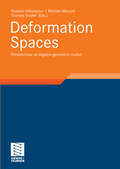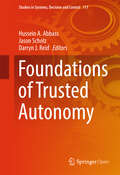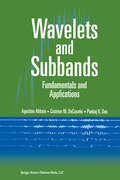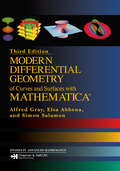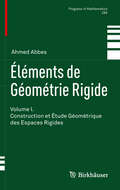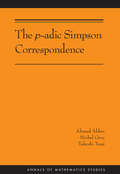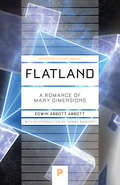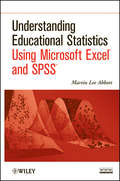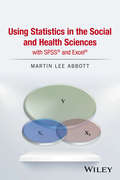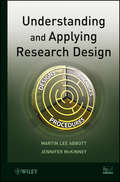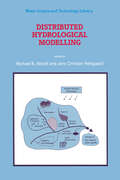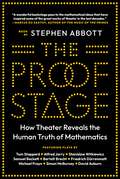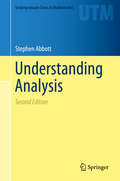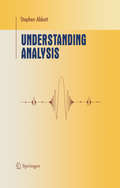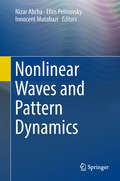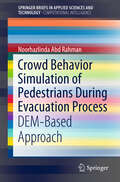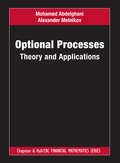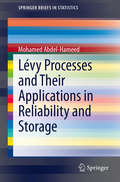- Table View
- List View
Deformation Spaces: Perspectives on algebro-geometric moduli (Aspects of Mathematics)
by Hossein Abbaspour Matilde Marcolli Thomas TradlerThe first instances of deformation theory were given by Kodaira and Spencer for complex structures and by Gerstenhaber for associative algebras. Since then, deformation theory has been applied as a useful tool in the study of many other mathematical structures, and even today it plays an important role in many developments of modern mathematics. This volume collects a few self-contained and peer-reviewed papers by experts which present up-to-date research topics in algebraic and motivic topology, quantum field theory, algebraic geometry, noncommutative geometry and the deformation theory of Poisson algebras. They originate from activities at the Max-Planck-Institute for Mathematics and the Hausdorff Center for Mathematics in Bonn.
Foundations of Trusted Autonomy (Studies in Systems, Decision and Control #117)
by Hussein A. Abbass Jason Scholz Darryn J. ReidThis book establishes the foundations needed to realize the ultimate goals for artificial intelligence, such as autonomy and trustworthiness. Aimed at scientists, researchers, technologists, practitioners, and students, it brings together contributions offering the basics, the challenges and the state-of-the-art on trusted autonomous systems in a single volume. The book is structured in three parts, with chapters written by eminent researchers and outstanding practitioners and users in the field. The first part covers foundational artificial intelligence technologies, while the second part covers philosophical, practical and technological perspectives on trust. Lastly, the third part presents advanced topics necessary to create future trusted autonomous systems. The book augments theory with real-world applications including cyber security, defence and space.
Wavelets and Subbands: Fundamentals and Applications (Applied and Numerical Harmonic Analysis)
by Agostino Abbate Casimer DeCusatis Pankaj K. DasThis book presents connections between the different aspects of wavelet and subband theory.
Modern Differential Geometry of Curves and Surfaces with Mathematica (Textbooks in Mathematics)
by Elsa Abbena Simon Salamon Alfred GrayPresenting theory while using Mathematica in a complementary way, Modern Differential Geometry of Curves and Surfaces with Mathematica, the third edition of Alfred Gray’s famous textbook, covers how to define and compute standard geometric functions using Mathematica for constructing new curves and surfaces from existing ones. Since Gray’s death, authors Abbena and Salamon have stepped in to bring the book up to date. While maintaining Gray's intuitive approach, they reorganized the material to provide a clearer division between the text and the Mathematica code and added a Mathematica notebook as an appendix to each chapter. They also address important new topics, such as quaternions. The approach of this book is at times more computational than is usual for a book on the subject. For example, Brioshi’s formula for the Gaussian curvature in terms of the first fundamental form can be too complicated for use in hand calculations, but Mathematica handles it easily, either through computations or through graphing curvature. Another part of Mathematica that can be used effectively in differential geometry is its special function library, where nonstandard spaces of constant curvature can be defined in terms of elliptic functions and then plotted. Using the techniques described in this book, readers will understand concepts geometrically, plotting curves and surfaces on a monitor and then printing them. Containing more than 300 illustrations, the book demonstrates how to use Mathematica to plot many interesting curves and surfaces. Including as many topics of the classical differential geometry and surfaces as possible, it highlights important theorems with many examples. It includes 300 miniprograms for computing and plotting various geometric objects, alleviating the drudgery of computing things such as the curvature and torsion of a curve in space.
Modern Differential Geometry of Curves and Surfaces with Mathematica (Textbooks in Mathematics)
by Elsa Abbena Simon Salamon Alfred GrayPresenting theory while using Mathematica in a complementary way, Modern Differential Geometry of Curves and Surfaces with Mathematica, the third edition of Alfred Gray’s famous textbook, covers how to define and compute standard geometric functions using Mathematica for constructing new curves and surfaces from existing ones. Since Gray’s death, authors Abbena and Salamon have stepped in to bring the book up to date. While maintaining Gray's intuitive approach, they reorganized the material to provide a clearer division between the text and the Mathematica code and added a Mathematica notebook as an appendix to each chapter. They also address important new topics, such as quaternions. The approach of this book is at times more computational than is usual for a book on the subject. For example, Brioshi’s formula for the Gaussian curvature in terms of the first fundamental form can be too complicated for use in hand calculations, but Mathematica handles it easily, either through computations or through graphing curvature. Another part of Mathematica that can be used effectively in differential geometry is its special function library, where nonstandard spaces of constant curvature can be defined in terms of elliptic functions and then plotted. Using the techniques described in this book, readers will understand concepts geometrically, plotting curves and surfaces on a monitor and then printing them. Containing more than 300 illustrations, the book demonstrates how to use Mathematica to plot many interesting curves and surfaces. Including as many topics of the classical differential geometry and surfaces as possible, it highlights important theorems with many examples. It includes 300 miniprograms for computing and plotting various geometric objects, alleviating the drudgery of computing things such as the curvature and torsion of a curve in space.
Éléments de Géométrie Rigide: Volume I. Construction et Étude Géométrique des Espaces Rigides (Progress in Mathematics #286)
by Ahmed AbbesLa géométrie rigide est devenue, au fil des ans, un outil indispensable dans un grand nombre de questions en géométrie arithmétique. Depuis ses premières fondations, posées par J. Tate en 1961, la théorie s'est développée dans des directions variées. Ce livre est le premier volume d'un traité qui expose un développement systématique de la géométrie rigide suivant l'approche de M. Raynaud, basée sur les schémas formels à éclatements admissibles près. Ce volume est consacré à la construction des espaces rigides dans une situation relative et à l'étude de leurs propriétés géométriques. L'accent est particulièrement mis sur l'étude de la topologie admissible d'un espace rigide cohérent, analogue de la topologie de Zariski d'un schéma. Parmi les sujets traités figurent l'étude des faisceaux cohérents et de leur cohomologie, le théorème de platification par éclatements admissibles qui généralise au cadre formel-rigide un théorème de Raynaud-Gruson dans le cadre algébrique, et le théorème de comparaison du type GAGA pour les faisceaux cohérents. Ce volume contient aussi de larges rappels et compléments de la théorie des schémas formels de Grothendieck. Ce traité est destiné tout autant aux étudiants ayant une bonne connaissance de la géométrie algébrique et souhaitant apprendre la géométrie rigide qu'aux experts en géométrie algébrique et en théorie des nombres comme source de références.
The p-adic Simpson Correspondence (AM-193)
by Ahmed Abbes Michel Gros Takeshi TsujiThe p-adic Simpson correspondence, recently initiated by Gerd Faltings, aims at describing all p-adic representations of the fundamental group of a proper smooth variety over a p-adic field in terms of linear algebra—namely Higgs bundles. This book undertakes a systematic development of the theory following two new approaches, one by Ahmed Abbes and Michel Gros, the other by Takeshi Tsuji. The authors mainly focus on generalized representations of the fundamental group that are p-adically close to the trivial representation.The first approach relies on a new family of period rings built from the torsor of deformations of the variety over a universal p-adic thickening defined by J. M. Fontaine. The second approach introduces a crystalline-type topos and replaces the notion of Higgs bundles with that of Higgs isocrystals. The authors show the compatibility of the two constructions and the compatibility of the correspondence with the natural cohomologies. The last part of the volume contains results of wider interest in p-adic Hodge theory. The reader will find a concise introduction to Faltings' theory of almost étale extensions and a chapter devoted to the Faltings topos. Though this topos is the general framework for Faltings' approach in p-adic Hodge theory, it remains relatively unexplored. The authors present a new approach based on a generalization of P. Deligne's covanishing topos.
The p-adic Simpson Correspondence (AM-193)
by Ahmed Abbes Michel Gros Takeshi TsujiThe p-adic Simpson correspondence, recently initiated by Gerd Faltings, aims at describing all p-adic representations of the fundamental group of a proper smooth variety over a p-adic field in terms of linear algebra—namely Higgs bundles. This book undertakes a systematic development of the theory following two new approaches, one by Ahmed Abbes and Michel Gros, the other by Takeshi Tsuji. The authors mainly focus on generalized representations of the fundamental group that are p-adically close to the trivial representation.The first approach relies on a new family of period rings built from the torsor of deformations of the variety over a universal p-adic thickening defined by J. M. Fontaine. The second approach introduces a crystalline-type topos and replaces the notion of Higgs bundles with that of Higgs isocrystals. The authors show the compatibility of the two constructions and the compatibility of the correspondence with the natural cohomologies. The last part of the volume contains results of wider interest in p-adic Hodge theory. The reader will find a concise introduction to Faltings' theory of almost étale extensions and a chapter devoted to the Faltings topos. Though this topos is the general framework for Faltings' approach in p-adic Hodge theory, it remains relatively unexplored. The authors present a new approach based on a generalization of P. Deligne's covanishing topos.
Flatland: A Romance of Many Dimensions
by Edwin Abbott Abbott Thomas BanchoffIn 1884, Edwin Abbott Abbott wrote a mathematical adventure set in a two-dimensional plane world, populated by a hierarchical society of regular geometrical figures-who think and speak and have all too human emotions. Since then Flatland has fascinated generations of readers, becoming a perennial science-fiction favorite. By imagining the contact of beings from different dimensions, the author fully exploited the power of the analogy between the limitations of humans and those of his two-dimensional characters. A first-rate fictional guide to the concept of multiple dimensions of space, the book will also appeal to those who are interested in computer graphics. This field, which literally makes higher dimensions seeable, has aroused a new interest in visualization. We can now manipulate objects in four dimensions and observe their three-dimensional slices tumbling on the computer screen. But how do we interpret these images? In his introduction, Thomas Banchoff points out that there is no better way to begin exploring the problem of understanding higher-dimensional slicing phenomena than reading this classic novel of the Victorian era.
Flatland: A Romance of Many Dimensions
by Edwin Abbott Abbott Thomas BanchoffIn 1884, Edwin Abbott Abbott wrote a mathematical adventure set in a two-dimensional plane world, populated by a hierarchical society of regular geometrical figures-who think and speak and have all too human emotions. Since then Flatland has fascinated generations of readers, becoming a perennial science-fiction favorite. By imagining the contact of beings from different dimensions, the author fully exploited the power of the analogy between the limitations of humans and those of his two-dimensional characters. A first-rate fictional guide to the concept of multiple dimensions of space, the book will also appeal to those who are interested in computer graphics. This field, which literally makes higher dimensions seeable, has aroused a new interest in visualization. We can now manipulate objects in four dimensions and observe their three-dimensional slices tumbling on the computer screen. But how do we interpret these images? In his introduction, Thomas Banchoff points out that there is no better way to begin exploring the problem of understanding higher-dimensional slicing phenomena than reading this classic novel of the Victorian era.
Understanding Educational Statistics Using Microsoft Excel and SPSS
by Martin Lee AbbottUtilizing the latest software, this book presents the essential statistical procedures for drawing valuable results from data in the social sciences. Mobilizing interesting real-world examples from the field of education, Understanding Educational Statistics Using Microsoft Excel and SPSS supplies a seamless presentation that identifies valuable connections between statistical applications and research design. Class-tested to ensure an accessible presentation, the book combines clear, step-by-step explanations and the use of software packages that are accessible to both the novice and professional alike to present the fundamental statistical practices for organizing, understanding, and drawing conclusions from educational research data. The book begines with an introduction to descriptive and inferential statistics and then proceeds to acquaint readers with the various functions for working with quantitative data in the Microsoft Excel environment, such as spreadsheet navigation; sorting and filtering; and creating pivot tables. Subsequent chapters treat the procedures that are commonly-employed when working with data across various fields of social science research, including: Single-sample tests Repeated measure tests Independent t-tests One way ANOVA and factorial ANOVA Correlation Bivariate regression Chi square Multiple regression Individual chapters are devoted to specific procedures, each ending with a lab exercise that highlights the importance of that procedure by posing a research question, examining the question through its application in Excel and SPSS, and concluding with a brief research report that outlines key findings drawn from the results. Real-world examples and data from modern educational research are used throughout the book, and a related Web site features additional data sets, examples, and labs, allowing readers to reinforce their comprehension of the material. Bridging traditional statistical topics with the latest software and applications in the field of education, Understanding Educational Statistics Using Microsoft Excel and SPSS is an excellent book for courses on educational research methods and introductory statistics in the social sciences at the upper-undergraduate and graduate levels. It also serves as a valuable resource for researchers and practitioners in the fields of education, psychology, and the social sciences who require a statistical background to work with data in their everyday work.
Understanding Educational Statistics Using Microsoft Excel and SPSS
by Martin Lee AbbottUtilizing the latest software, this book presents the essential statistical procedures for drawing valuable results from data in the social sciences. Mobilizing interesting real-world examples from the field of education, Understanding Educational Statistics Using Microsoft Excel and SPSS supplies a seamless presentation that identifies valuable connections between statistical applications and research design. Class-tested to ensure an accessible presentation, the book combines clear, step-by-step explanations and the use of software packages that are accessible to both the novice and professional alike to present the fundamental statistical practices for organizing, understanding, and drawing conclusions from educational research data. The book begines with an introduction to descriptive and inferential statistics and then proceeds to acquaint readers with the various functions for working with quantitative data in the Microsoft Excel environment, such as spreadsheet navigation; sorting and filtering; and creating pivot tables. Subsequent chapters treat the procedures that are commonly-employed when working with data across various fields of social science research, including: Single-sample tests Repeated measure tests Independent t-tests One way ANOVA and factorial ANOVA Correlation Bivariate regression Chi square Multiple regression Individual chapters are devoted to specific procedures, each ending with a lab exercise that highlights the importance of that procedure by posing a research question, examining the question through its application in Excel and SPSS, and concluding with a brief research report that outlines key findings drawn from the results. Real-world examples and data from modern educational research are used throughout the book, and a related Web site features additional data sets, examples, and labs, allowing readers to reinforce their comprehension of the material. Bridging traditional statistical topics with the latest software and applications in the field of education, Understanding Educational Statistics Using Microsoft Excel and SPSS is an excellent book for courses on educational research methods and introductory statistics in the social sciences at the upper-undergraduate and graduate levels. It also serves as a valuable resource for researchers and practitioners in the fields of education, psychology, and the social sciences who require a statistical background to work with data in their everyday work.
Using Statistics in the Social and Health Sciences with SPSS and Excel
by Martin Lee AbbottProvides a step-by-step approach to statistical procedures to analyze data and conduct research, with detailed sections in each chapter explaining SPSS® and Excel® applications This book identifies connections between statistical applications and research design using cases, examples, and discussion of specific topics from the social and health sciences. Researched and class-tested to ensure an accessible presentation, the book combines clear, step-by-step explanations for both the novice and professional alike to understand the fundamental statistical practices for organizing, analyzing, and drawing conclusions from research data in their field. The book begins with an introduction to descriptive and inferential statistics and then acquaints readers with important features of statistical applications (SPSS and Excel) that support statistical analysis and decision making. Subsequent chapters treat the procedures commonly employed when working with data across various fields of social science research. Individual chapters are devoted to specific statistical procedures, each ending with lab application exercises that pose research questions, examine the questions through their application in SPSS and Excel, and conclude with a brief research report that outlines key findings drawn from the results. Real-world examples and data from social and health sciences research are used throughout the book, allowing readers to reinforce their comprehension of the material. Using Statistics in the Social and Health Sciences with SPSS® and Excel® includes: Use of straightforward procedures and examples that help students focus on understanding of analysis and interpretation of findings Inclusion of a data lab section in each chapter that provides relevant, clear examples Introduction to advanced statistical procedures in chapter sections (e.g., regression diagnostics) and separate chapters (e.g., multiple linear regression) for greater relevance to real-world research needs Emphasizing applied statistical analyses, this book can serve as the primary text in undergraduate and graduate university courses within departments of sociology, psychology, urban studies, health sciences, and public health, as well as other related departments. It will also be useful to statistics practitioners through extended sections using SPSS® and Excel® for analyzing data.
Using Statistics in the Social and Health Sciences with SPSS and Excel
by Martin Lee AbbottProvides a step-by-step approach to statistical procedures to analyze data and conduct research, with detailed sections in each chapter explaining SPSS® and Excel® applications This book identifies connections between statistical applications and research design using cases, examples, and discussion of specific topics from the social and health sciences. Researched and class-tested to ensure an accessible presentation, the book combines clear, step-by-step explanations for both the novice and professional alike to understand the fundamental statistical practices for organizing, analyzing, and drawing conclusions from research data in their field. The book begins with an introduction to descriptive and inferential statistics and then acquaints readers with important features of statistical applications (SPSS and Excel) that support statistical analysis and decision making. Subsequent chapters treat the procedures commonly employed when working with data across various fields of social science research. Individual chapters are devoted to specific statistical procedures, each ending with lab application exercises that pose research questions, examine the questions through their application in SPSS and Excel, and conclude with a brief research report that outlines key findings drawn from the results. Real-world examples and data from social and health sciences research are used throughout the book, allowing readers to reinforce their comprehension of the material. Using Statistics in the Social and Health Sciences with SPSS® and Excel® includes: Use of straightforward procedures and examples that help students focus on understanding of analysis and interpretation of findings Inclusion of a data lab section in each chapter that provides relevant, clear examples Introduction to advanced statistical procedures in chapter sections (e.g., regression diagnostics) and separate chapters (e.g., multiple linear regression) for greater relevance to real-world research needs Emphasizing applied statistical analyses, this book can serve as the primary text in undergraduate and graduate university courses within departments of sociology, psychology, urban studies, health sciences, and public health, as well as other related departments. It will also be useful to statistics practitioners through extended sections using SPSS® and Excel® for analyzing data.
Understanding and Applying Research Design
by Martin Lee Abbott Jennifer McKinneyA fresh approach to bridging research design with statistical analysis While good social science requires both research design and statistical analysis, most books treat these two areas separately. Understanding and Applying Research Design introduces an accessible approach to integrating design and statistics, focusing on the processes of posing, testing, and interpreting research questions in the social sciences. The authors analyze real-world data using SPSS software, guiding readers on the overall process of science, focusing on premises, procedures, and designs of social scientific research. Three clearly organized sections move seamlessly from theoretical topics to statistical techniques at the heart of research procedures, and finally, to practical application of research design: Premises of Research introduces the research process and the capabilities of SPSS, with coverage of ethics, Empirical Generalization, and Chi Square and Contingency Table Analysis Procedures of Research explores key quantitative methods in research design including measurement, correlation, regression, and causation Designs of Research outlines various design frameworks, with discussion of survey research, aggregate research, and experiments Throughout the book, SPSS software is used to showcase the discussed techniques, and detailed appendices provide guidance on key statistical procedures and tips for data management. Numerous exercises allow readers to test their comprehension of the presented material, and a related website features additional data sets and SPSS code. Understanding and Applying Research Design is an excellent book for social sciences and education courses on research methods at the upper-undergraduate level. The book is also an insightful reference for professionals who would like to learn how to pose, test, and interpret research questions with confidence.
Understanding and Applying Research Design
by Martin Lee Abbott Jennifer McKinneyA fresh approach to bridging research design with statistical analysis While good social science requires both research design and statistical analysis, most books treat these two areas separately. Understanding and Applying Research Design introduces an accessible approach to integrating design and statistics, focusing on the processes of posing, testing, and interpreting research questions in the social sciences. The authors analyze real-world data using SPSS software, guiding readers on the overall process of science, focusing on premises, procedures, and designs of social scientific research. Three clearly organized sections move seamlessly from theoretical topics to statistical techniques at the heart of research procedures, and finally, to practical application of research design: Premises of Research introduces the research process and the capabilities of SPSS, with coverage of ethics, Empirical Generalization, and Chi Square and Contingency Table Analysis Procedures of Research explores key quantitative methods in research design including measurement, correlation, regression, and causation Designs of Research outlines various design frameworks, with discussion of survey research, aggregate research, and experiments Throughout the book, SPSS software is used to showcase the discussed techniques, and detailed appendices provide guidance on key statistical procedures and tips for data management. Numerous exercises allow readers to test their comprehension of the presented material, and a related website features additional data sets and SPSS code. Understanding and Applying Research Design is an excellent book for social sciences and education courses on research methods at the upper-undergraduate level. The book is also an insightful reference for professionals who would like to learn how to pose, test, and interpret research questions with confidence.
Distributed Hydrological Modelling (Water Science and Technology Library #22)
by Michael B. Abbott Jens Christian RefsgaardIt is the task of the engineer, as of any other professional person, to do everything that is reasonably possible to analyse the difficulties with which his or her client is confronted, and on this basis to design solutions and implement these in practice. The distributed hydrological model is, correspondingly, the means for doing everything that is reasonably possible - of mobilising as much data and testing it with as much knowledge as is economically feasible - for the purpose of analysing problems and of designing and implementing remedial measures in the case of difficulties arising within the hydrological cycle. Thus the aim of distributed hydrologic modelling is to make the fullest use of cartographic data, of geological data, of satellite data, of stream discharge measurements, of borehole data, of observations of crops and other vegetation, of historical records of floods and droughts, and indeed of everything else that has ever been recorded or remembered, and then to apply to this everything that is known about meteorology, plant physiology, soil physics, hydrogeology, sediment transport and everything else that is relevant within this context. Of course, no matter how much data we have and no matter how much we know, it will never be enough to treat some problems and some situations, but still we can aim in this way to do the best that we possibly can.
The Proof Stage: How Theater Reveals the Human Truth of Mathematics
by Stephen AbbottHow playwrights from Alfred Jarry and Samuel Beckett to Tom Stoppard and Simon McBurney brought the power of abstract mathematics to the human stageThe discovery of alternate geometries, paradoxes of the infinite, incompleteness, and chaos theory revealed that, despite its reputation for certainty, mathematical truth is not immutable, perfect, or even perfectible. Beginning in the last century, a handful of adventurous playwrights took inspiration from the fractures of modern mathematics to expand their own artistic boundaries. Originating in the early avant-garde, mathematics-infused theater reached a popular apex in Tom Stoppard’s 1993 play Arcadia. In The Proof Stage, mathematician Stephen Abbott explores this unlikely collaboration of theater and mathematics. He probes the impact of mathematics on such influential writers as Alfred Jarry, Samuel Beckett, Bertolt Brecht, and Stoppard, and delves into the life and mathematics of Alan Turing as they are rendered onstage. The result is an unexpected story about the mutually illuminating relationship between proofs and plays—from Euclid and Euripides to Gödel and Godot.Theater is uniquely poised to discover the soulful, human truths embedded in the austere theorems of mathematics, but this is a difficult feat. It took Stoppard twenty-five years of experimenting with the creative possibilities of mathematics before he succeeded in making fractal geometry and chaos theory integral to Arcadia’s emotional arc. In addition to charting Stoppard’s journey, Abbott examines the post-Arcadia wave of ambitious works by Michael Frayn, David Auburn, Simon McBurney, Snoo Wilson, John Mighton, and others. Collectively, these gifted playwrights transform the great philosophical upheavals of mathematics into profound and sometimes poignant revelations about the human journey.
Understanding Analysis (Undergraduate Texts in Mathematics)
by Stephen AbbottThis lively introductory text exposes the student to the rewards of a rigorous study of functions of a real variable. In each chapter, informal discussions of questions that give analysis its inherent fascination are followed by precise, but not overly formal, developments of the techniques needed to make sense of them. By focusing on the unifying themes of approximation and the resolution of paradoxes that arise in the transition from the finite to the infinite, the text turns what could be a daunting cascade of definitions and theorems into a coherent and engaging progression of ideas. Acutely aware of the need for rigor, the student is much better prepared to understand what constitutes a proper mathematical proof and how to write one.Fifteen years of classroom experience with the first edition of Understanding Analysis have solidified and refined the central narrative of the second edition. Roughly 150 new exercises join a selection of the best exercises from the first edition, and three more project-style sections have been added. Investigations of Euler’s computation of ζ(2), the Weierstrass Approximation Theorem, and the gamma function are now among the book’s cohort of seminal results serving as motivation and payoff for the beginning student to master the methods of analysis.
Understanding Analysis (Undergraduate Texts in Mathematics)
by Stephen AbbottThis elementary presentation exposes readers to both the process of rigor and the rewards inherent in taking an axiomatic approach to the study of functions of a real variable. The aim is to challenge and improve mathematical intuition rather than to verify it. The philosophy of this book is to focus attention on questions which give analysis its inherent fascination. Each chapter begins with the discussion of some motivating examples and concludes with a series of questions.
Nonlinear Waves and Pattern Dynamics
by Nizar Abcha Efim Pelinovsky Innocent MutabaziThis book addresses the fascinating phenomena associated with nonlinear waves and spatio-temporal patterns. These appear almost everywhere in nature from sand bed forms to brain patterns, and yet their understanding still presents fundamental scientific challenges. The reader will learn here, in particular, about the current state-of-the art and new results in: Nonlinear water waves: resonance, solitons, focusing, Bose-Einstein condensation, as well as and their relevance for the sea environment (sea-wind interaction, sand bed forms, fiber clustering) Pattern formation in non-equilibrium media: soap films, chimera patterns in oscillating media, viscoelastic Couette-Taylor flow, flow in the wake behind a heated cylinder, other pattern formation. The editors and authors dedicate this book to the memory of Alexander Ezersky, Professor of Fluid Mechanics at the University of Caen Normandie (France) from September 2007 to July 2016. Before 2007, he had served as a Senior Scientist at the Institute of Applied Physics of the Russian Academy of Sciences in Nizhny Novgorod (Russia). The chapters have been written by leading scientists in Nonlinear Physics, and the topics chosen so as to cover all the fields to which Prof. Ezersky himself contributed, by means of experimental, theoretical and numerical approaches. The volume will appeal to advanced students and researchers studying nonlinear waves and pattern dynamics, as well as other scientists interested in their applications in various natural media.
Crowd Behavior Simulation of Pedestrians During Evacuation Process: DEM-Based Approach (SpringerBriefs in Applied Sciences and Technology)
by Noorhazlinda Abd RahmanThis book introduces the use of the distinct element method (DEM) in modeling crowd behavior and simulating evacuation processes. Focusing on the mathematical computation of the uncertain behavior of evacuees, which is switching action behavior, it subsequently reproduces the crowd evacuation process under several conjectural scenarios using a DEM-based multi-agent model that has been modified by introducing the switching action behavior. The proposed switching action behavior model describes a person who has to change his/her destination due to the limited space capacity of the designated evacuation area. The change in the destination of a person is determined according to the motion of other individuals in the perception domain during the defined switching action time. The switching action time is formulated in the so-called switching action function, which is described by a convolution integral of the input and unit response functions. The newly developed switching action model is then validated using sensitivity analysis in which the primary focus is the crowd motion and flow of switching action behavior.
Optional Processes: Theory and Applications (Chapman and Hall/CRC Financial Mathematics Series)
by Mohamed Abdelghani Alexander MelnikovIt is well-known that modern stochastic calculus has been exhaustively developed under usual conditions. Despite such a well-developed theory, there is evidence to suggest that these very convenient technical conditions cannot necessarily be fulfilled in real-world applications. Optional Processes: Theory and Applications seeks to delve into the existing theory, new developments and applications of optional processes on "unusual" probability spaces. The development of stochastic calculus of optional processes marks the beginning of a new and more general form of stochastic analysis. This book aims to provide an accessible, comprehensive and up-to-date exposition of optional processes and their numerous properties. Furthermore, the book presents not only current theory of optional processes, but it also contains a spectrum of applications to stochastic differential equations, filtering theory and mathematical finance. Features Suitable for graduate students and researchers in mathematical finance, actuarial science, applied mathematics and related areas Compiles almost all essential results on the calculus of optional processes in unusual probability spaces Contains many advanced analytical results for stochastic differential equations and statistics pertaining to the calculus of optional processes Develops new methods in finance based on optional processes such as a new portfolio theory, defaultable claim pricing mechanism, etc.
Optional Processes: Theory and Applications (Chapman and Hall/CRC Financial Mathematics Series)
by Mohamed Abdelghani Alexander MelnikovIt is well-known that modern stochastic calculus has been exhaustively developed under usual conditions. Despite such a well-developed theory, there is evidence to suggest that these very convenient technical conditions cannot necessarily be fulfilled in real-world applications. Optional Processes: Theory and Applications seeks to delve into the existing theory, new developments and applications of optional processes on "unusual" probability spaces. The development of stochastic calculus of optional processes marks the beginning of a new and more general form of stochastic analysis. This book aims to provide an accessible, comprehensive and up-to-date exposition of optional processes and their numerous properties. Furthermore, the book presents not only current theory of optional processes, but it also contains a spectrum of applications to stochastic differential equations, filtering theory and mathematical finance. Features Suitable for graduate students and researchers in mathematical finance, actuarial science, applied mathematics and related areas Compiles almost all essential results on the calculus of optional processes in unusual probability spaces Contains many advanced analytical results for stochastic differential equations and statistics pertaining to the calculus of optional processes Develops new methods in finance based on optional processes such as a new portfolio theory, defaultable claim pricing mechanism, etc.
Lévy Processes and Their Applications in Reliability and Storage (SpringerBriefs in Statistics)
by Mohamed Abdel-HameedThis book covers Lévy processes and their applications in the contexts of reliability and storage. Special attention is paid to life distributions and the maintenance of devices subject to degradation; estimating the parameters of the degradation process is also discussed, as is the maintenance of dams subject to Lévy input.
